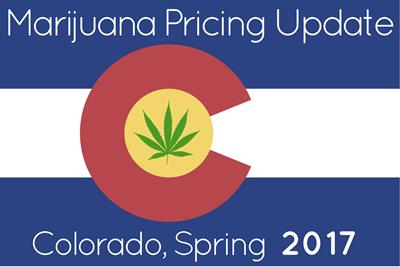
Thursday June 22, 2017
 Education
Education
Summer is here, which means it’s the perfect time to catch up on marijuana prices from this past spring. We’ve compiled data from hundreds of dispensaries across Colorado to bring you the most current trends and information on marijuana prices in the Centennial State.
Of course, we couldn’t bring you this data without our friends at BDS Analytics. They expertly aggregate point of sale information from Colorado dispensaries and create detailed reports that shed light onto the ever-fluctuating cannabis market. This information helps us bring you the most accurate marijuana pricing updates out there. Without further hesitation, let’s dive into the details.
Marijuana Prices in Colorado
Price is a key component of supply and demand. Colorado’s projections for the tax and revenue opportunities from the cannabis industry are predicated on falling prices inducing consumers to choose the regulated market vs. the black market. The state’s thinking has mostly been on target; prices have declined, the market has expanded significantly, and tax revenues are flowing into state and local coffers.
No product category better exemplifies supply and demand economics at play like flower which has become a commodity in a state that allows for vertical integration as well as wholesalers and brands.
Between January 2014 and April of 2017, Colorado’s legal cannabis market has generated an astounding $2 billion from the sales of flower/bud at dispensaries and retailers across the state. An analysis of retail/dispensary sales data from BDS Analytics indicates that year-to-date through April, the average gram of flower sold in Colorado went for $5.83 (pre-tax) across both adult-use and medical channels combined. Adult-Use/Rec retailers had an average retail of $6.92 per gram, medical dispensaries came in at an appropriate $4.20 a gram.
Compared to the same period in 2014, sales of flower year-to-date in 2017 ($169 million) have increased 280 percent at adult-use retailers; in that time sales volume increased 393 percent and retail prices dropped $2.04 per gram on average. Over the same time-frame, sales in the medical channel increased 9 percent in units but with retail prices dropping $2.40 a gram, revenues from flower are down 31 percent compared to 2014.
More recently, In March of this year, flower prices declined to a new low of $5.60 (Pre-tax) across both channels combined, but prices rebounded slightly in April. In April, flower prices in the adult-use channel were $6.95 a gram. In contrast, prices in the medical channel were just $4.07 a gram.
At the store/dispensary level, prices still vary widely with some choosing to offer low prices that drive volume purchasing, while others take the opposite approach of charging premium prices despite significant competition. Retailers are finding success on both ends of the pricing spectrum indicating that there are many types of cannabis consumers with different motivations.
The low-end of the pricing spectrum bottomed out months ago, at least for the time being. In January, we witnessed a new high price as some retailers have found consumers willing to pay for premium strains with limited availability.
Top selling strains tend to be priced a little above average as products in demand generally don’t require as much discounting. Combining sales at both adult-use and medical dispensaries, the average price per gram (pre-tax) for the top 10 selling strains in 2017 was $6.45, 10.6 percent higher than the average for all flower.
| Top 10 Selling Strains by Volume | |
|---|---|
| Strain | Avg Price Per Gram |
| Blue Dream | $5.50 |
| Golden Goat | $6.04 |
| Durban Poison | $6.71 |
| Green Crack | $5.50 |
| Sour Diesel | $7.03 |
| Chemdawg | $6.65 |
| Lemon Skunk | $6.04 |
| Flo | $6.44 |
| Kosher Kush | $7.26 |
| JillyBean | $7.31 |












